Abstract
The connective-tissue disorder occipital horn syndrome (OHS) is hypothesized to be allelic to Menkes disease. The two diseases have different clinical presentations but have a similar abnormality of copper transport. Mice hemizygous for the blotchy allele of the X-linked mottled locus have similar connective-tissue defects as OHS and may represent a mouse model of this disease. We have analyzed the Menkes/mottled copper-transporting ATPase in these two potentially homologous disorders and have identified similar splicing mutations in both. Some expression of normal mRNA was detectable by reverse transcription-PCR in the mutant tissues. These findings contrast with the more debilitating mutations observed in Menkes disease and suggest that low amounts of an otherwise normal protein product could result in the relatively mild phenotype of OHS and of the blotchy mouse.
Full text
PDF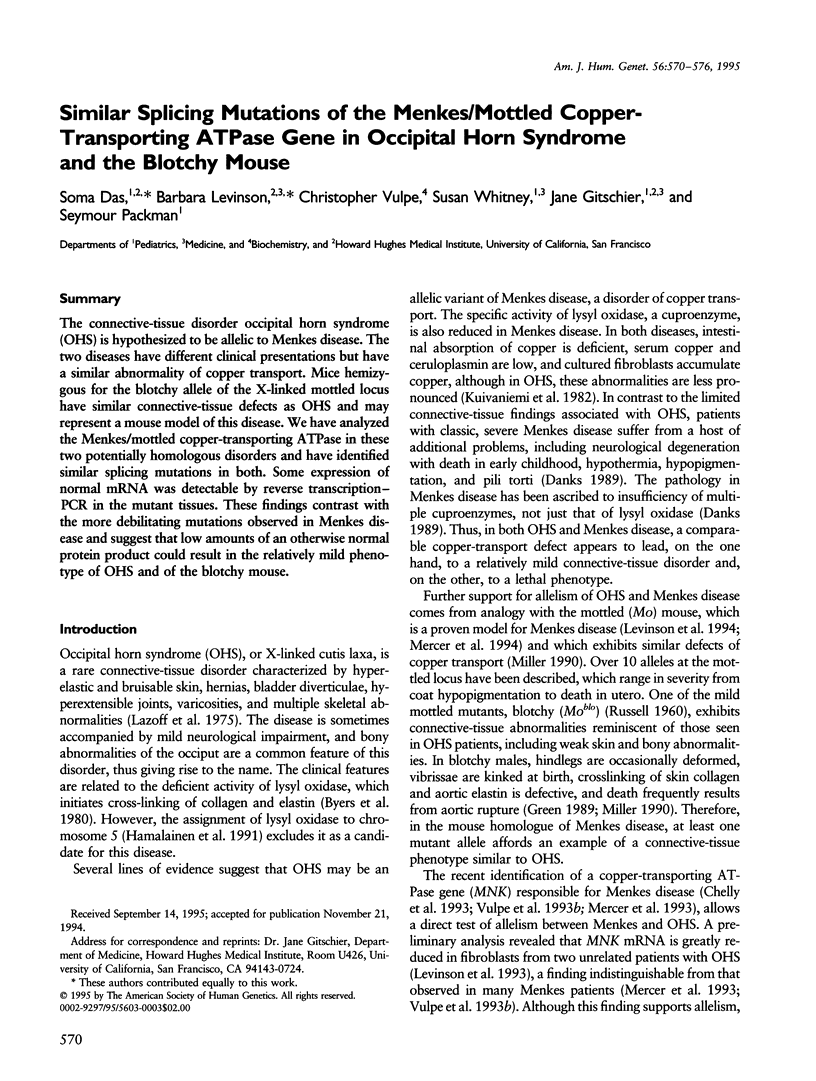
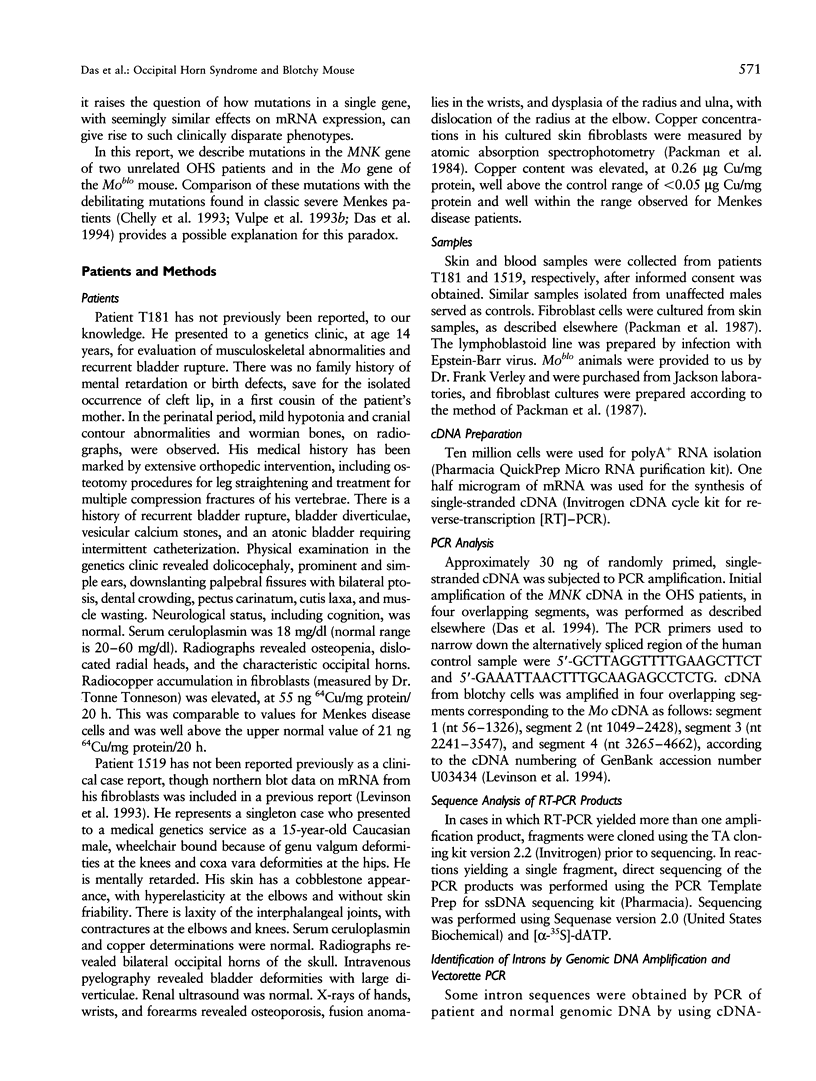
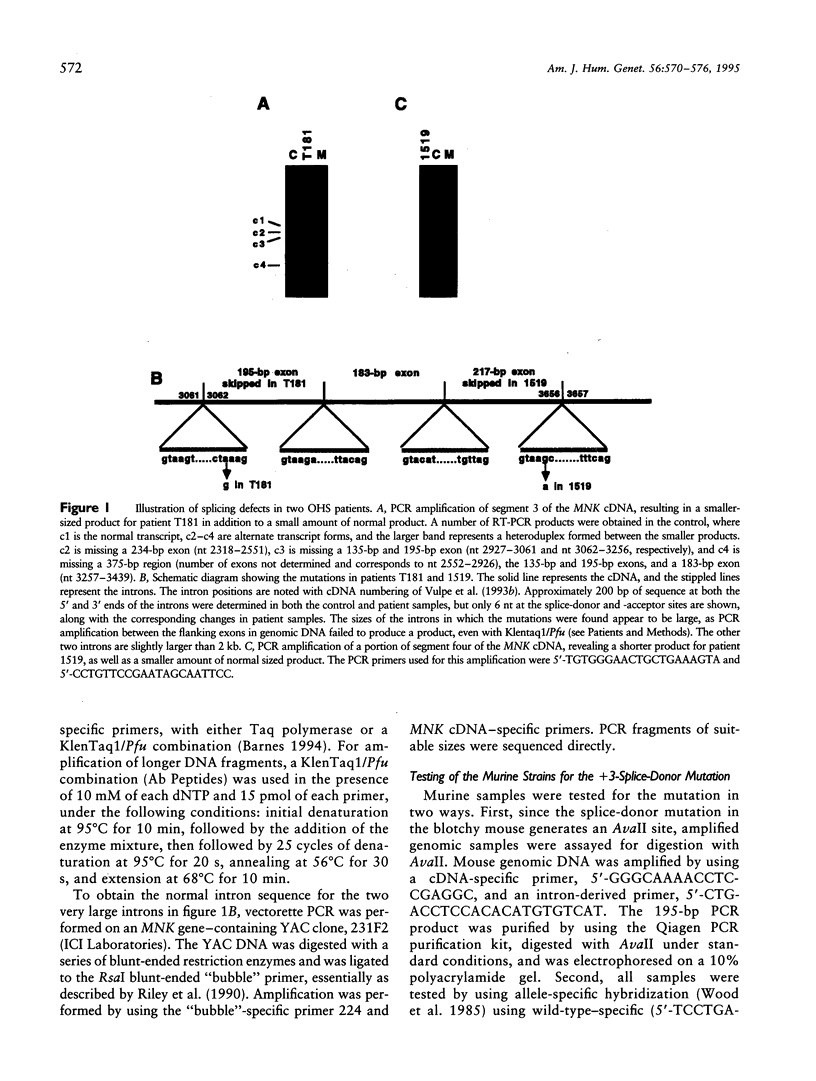
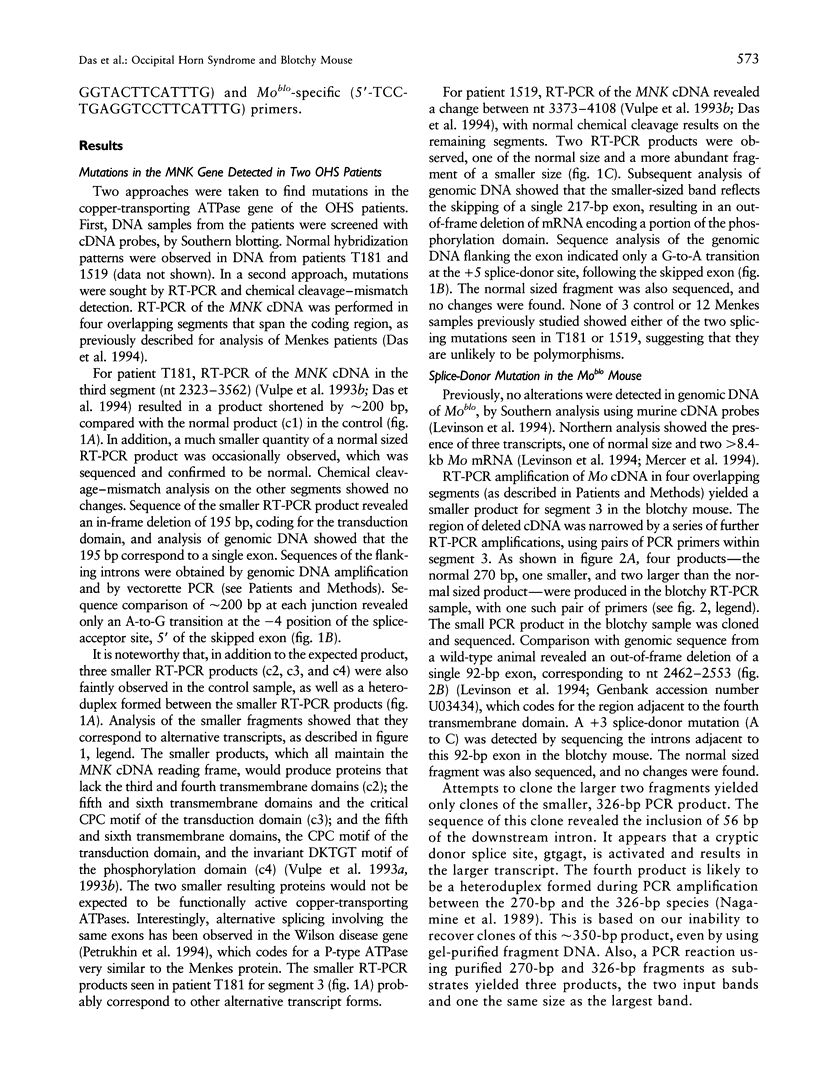
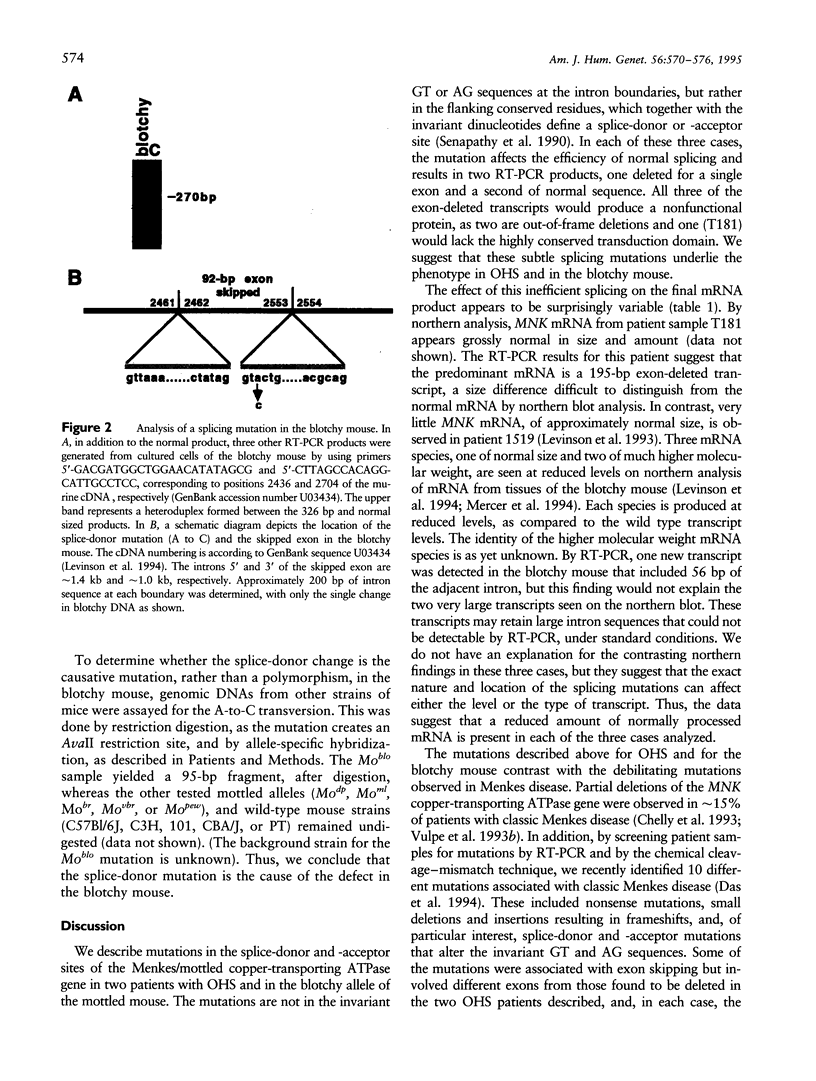
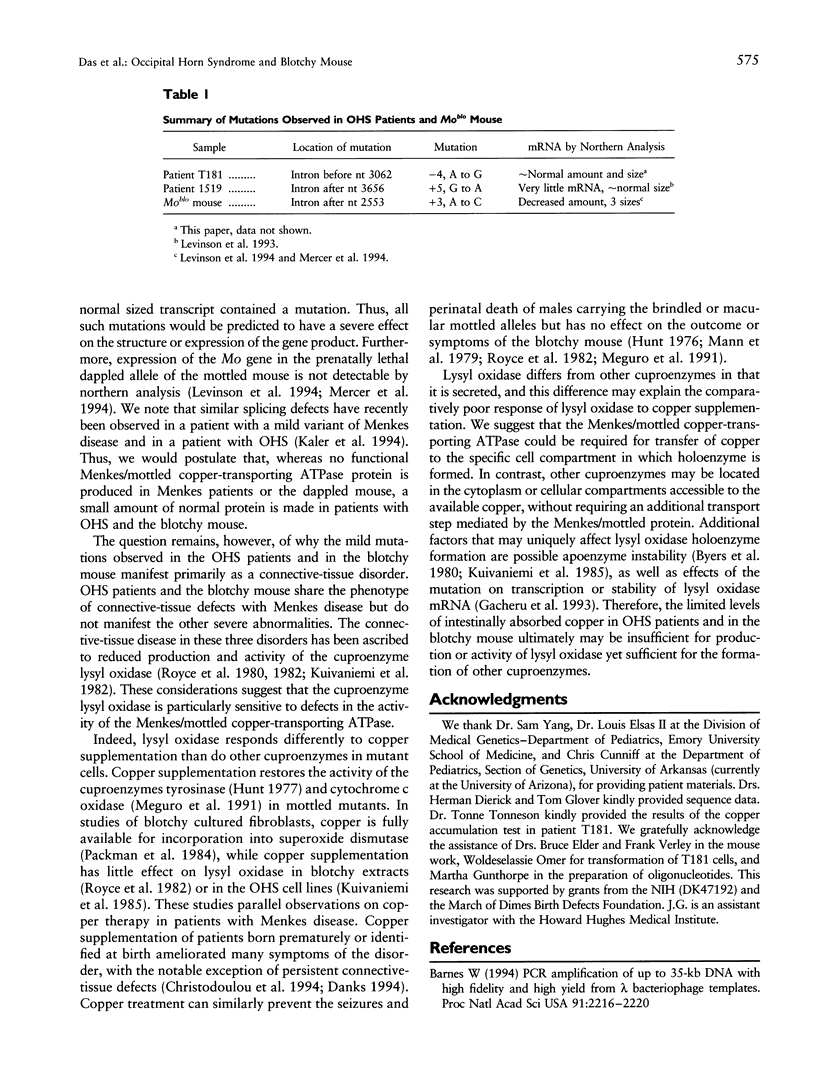
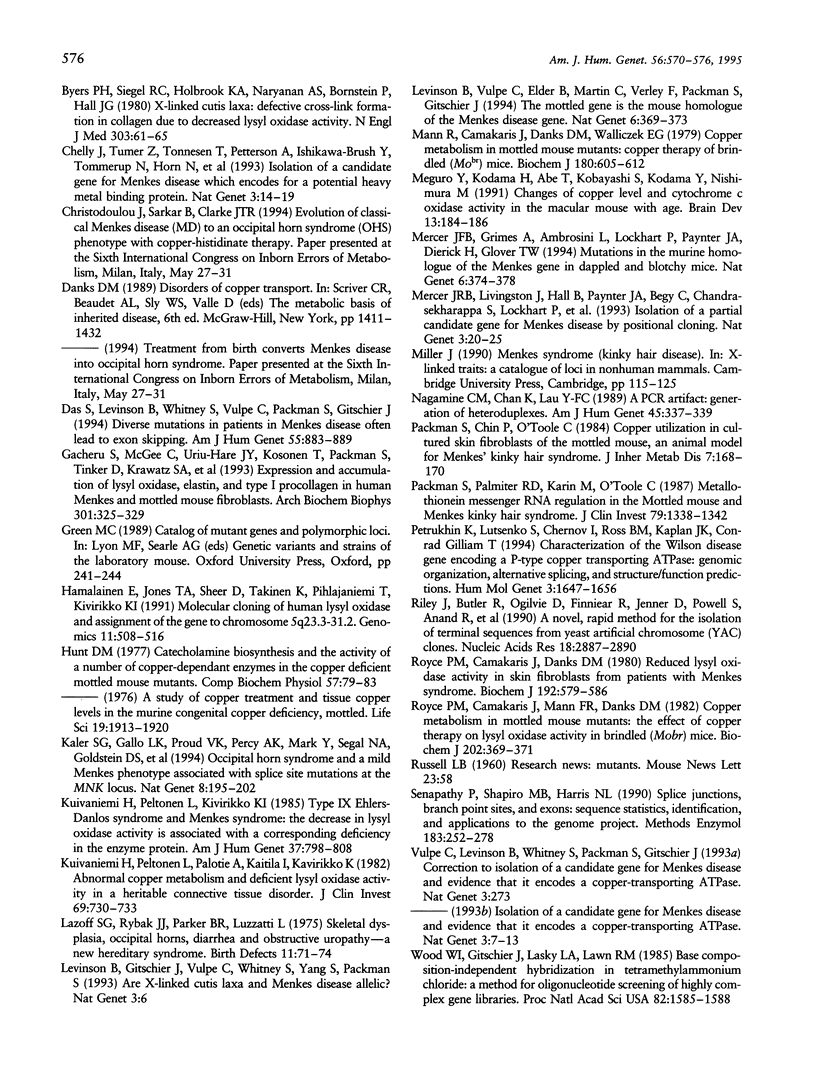
Images in this article
Selected References
These references are in PubMed. This may not be the complete list of references from this article.
- Barnes W. M. PCR amplification of up to 35-kb DNA with high fidelity and high yield from lambda bacteriophage templates. Proc Natl Acad Sci U S A. 1994 Mar 15;91(6):2216–2220. doi: 10.1073/pnas.91.6.2216. [DOI] [PMC free article] [PubMed] [Google Scholar]
- Byers P. H., Siegel R. C., Holbrook K. A., Narayanan A. S., Bornstein P., Hall J. G. X-linked cutis laxa: defective cross-link formation in collagen due to decreased lysyl oxidase activity. N Engl J Med. 1980 Jul 10;303(2):61–65. doi: 10.1056/NEJM198007103030201. [DOI] [PubMed] [Google Scholar]
- Chelly J., Tümer Z., Tønnesen T., Petterson A., Ishikawa-Brush Y., Tommerup N., Horn N., Monaco A. P. Isolation of a candidate gene for Menkes disease that encodes a potential heavy metal binding protein. Nat Genet. 1993 Jan;3(1):14–19. doi: 10.1038/ng0193-14. [DOI] [PubMed] [Google Scholar]
- Das S., Levinson B., Whitney S., Vulpe C., Packman S., Gitschier J. Diverse mutations in patients with Menkes disease often lead to exon skipping. Am J Hum Genet. 1994 Nov;55(5):883–889. [PMC free article] [PubMed] [Google Scholar]
- Gacheru S., McGee C., Uriu-Hare J. Y., Kosonen T., Packman S., Tinker D., Krawetz S. A., Reiser K., Keen C. L., Rucker R. B. Expression and accumulation of lysyl oxidase, elastin, and type I procollagen in human Menkes and mottled mouse fibroblasts. Arch Biochem Biophys. 1993 Mar;301(2):325–329. doi: 10.1006/abbi.1993.1151. [DOI] [PubMed] [Google Scholar]
- Hunt D. M. Catecholamine biosynthesis and the activity of a number of copper-dependent enzymes in the copper deficient mottled mouse mutants. Comp Biochem Physiol C. 1977;57(1):79–83. doi: 10.1016/0306-4492(77)90082-x. [DOI] [PubMed] [Google Scholar]
- Hämäläinen E. R., Jones T. A., Sheer D., Taskinen K., Pihlajaniemi T., Kivirikko K. I. Molecular cloning of human lysyl oxidase and assignment of the gene to chromosome 5q23.3-31.2. Genomics. 1991 Nov;11(3):508–516. doi: 10.1016/0888-7543(91)90057-l. [DOI] [PubMed] [Google Scholar]
- Kaler S. G., Gallo L. K., Proud V. K., Percy A. K., Mark Y., Segal N. A., Goldstein D. S., Holmes C. S., Gahl W. A. Occipital horn syndrome and a mild Menkes phenotype associated with splice site mutations at the MNK locus. Nat Genet. 1994 Oct;8(2):195–202. doi: 10.1038/ng1094-195. [DOI] [PubMed] [Google Scholar]
- Kuivaniemi H., Peltonen L., Kivirikko K. I. Type IX Ehlers-Danlos syndrome and Menkes syndrome: the decrease in lysyl oxidase activity is associated with a corresponding deficiency in the enzyme protein. Am J Hum Genet. 1985 Jul;37(4):798–808. [PMC free article] [PubMed] [Google Scholar]
- Kuivaniemi H., Peltonen L., Palotie A., Kaitila I., Kivirikko K. I. Abnormal copper metabolism and deficient lysyl oxidase activity in a heritable connective tissue disorder. J Clin Invest. 1982 Mar;69(3):730–733. doi: 10.1172/JCI110503. [DOI] [PMC free article] [PubMed] [Google Scholar]
- Lazoff S. G., Rybak J. J., Parker B. R., Luzzatti L. Skeletal dysplasia, occipital horns, diarrhea and obstructive uropathy- a new hereditary syndrome. Birth Defects Orig Artic Ser. 1975;11(5):71–74. [PubMed] [Google Scholar]
- Levinson B., Gitschier J., Vulpe C., Whitney S., Yang S., Packman S. Are X-linked cutis laxa and Menkes disease allelic? Nat Genet. 1993 Jan;3(1):6–6. doi: 10.1038/ng0193-6. [DOI] [PubMed] [Google Scholar]
- Levinson B., Vulpe C., Elder B., Martin C., Verley F., Packman S., Gitschier J. The mottled gene is the mouse homologue of the Menkes disease gene. Nat Genet. 1994 Apr;6(4):369–373. doi: 10.1038/ng0494-369. [DOI] [PubMed] [Google Scholar]
- Mann J. R., Camakaris J., Danks D. M., Walliczek E. G. Copper metabolism in mottled mouse mutants: copper therapy of brindled (Mobr) mice. Biochem J. 1979 Jun 15;180(3):605–612. doi: 10.1042/bj1800605. [DOI] [PMC free article] [PubMed] [Google Scholar]
- Meguro Y., Kodama H., Abe T., Kobayashi S., Kodama Y., Nishimura M. Changes of copper level and cytochrome c oxidase activity in the macular mouse with age. Brain Dev. 1991 May;13(3):184–186. doi: 10.1016/s0387-7604(12)80027-1. [DOI] [PubMed] [Google Scholar]
- Mercer J. F., Grimes A., Ambrosini L., Lockhart P., Paynter J. A., Dierick H., Glover T. W. Mutations in the murine homologue of the Menkes gene in dappled and blotchy mice. Nat Genet. 1994 Apr;6(4):374–378. doi: 10.1038/ng0494-374. [DOI] [PubMed] [Google Scholar]
- Mercer J. F., Livingston J., Hall B., Paynter J. A., Begy C., Chandrasekharappa S., Lockhart P., Grimes A., Bhave M., Siemieniak D. Isolation of a partial candidate gene for Menkes disease by positional cloning. Nat Genet. 1993 Jan;3(1):20–25. doi: 10.1038/ng0193-20. [DOI] [PubMed] [Google Scholar]
- Nagamine C. M., Chan K., Lau Y. F. A PCR artifact: generation of heteroduplexes. Am J Hum Genet. 1989 Aug;45(2):337–339. [PMC free article] [PubMed] [Google Scholar]
- Packman S., Chin P., O'Toole C. Copper utilization in cultured skin fibroblasts of the mottled mouse, an animal model for Menkes' kinky hair syndrome. J Inherit Metab Dis. 1984;7(4):168–170. doi: 10.1007/BF01805602. [DOI] [PubMed] [Google Scholar]
- Packman S., Palmiter R. D., Karin M., O'Toole C. Metallothionein messenger RNA regulation in the mottled mouse and Menkes kinky hair syndrome. J Clin Invest. 1987 May;79(5):1338–1342. doi: 10.1172/JCI112959. [DOI] [PMC free article] [PubMed] [Google Scholar]
- Petrukhin K., Lutsenko S., Chernov I., Ross B. M., Kaplan J. H., Gilliam T. C. Characterization of the Wilson disease gene encoding a P-type copper transporting ATPase: genomic organization, alternative splicing, and structure/function predictions. Hum Mol Genet. 1994 Sep;3(9):1647–1656. doi: 10.1093/hmg/3.9.1647. [DOI] [PubMed] [Google Scholar]
- Riley J., Butler R., Ogilvie D., Finniear R., Jenner D., Powell S., Anand R., Smith J. C., Markham A. F. A novel, rapid method for the isolation of terminal sequences from yeast artificial chromosome (YAC) clones. Nucleic Acids Res. 1990 May 25;18(10):2887–2890. doi: 10.1093/nar/18.10.2887. [DOI] [PMC free article] [PubMed] [Google Scholar]
- Royce P. M., Camakaris J., Danks D. M. Reduced lysyl oxidase activity in skin fibroblasts from patients with Menkes' syndrome. Biochem J. 1980 Nov 15;192(2):579–586. doi: 10.1042/bj1920579. [DOI] [PMC free article] [PubMed] [Google Scholar]
- Royce P. M., Camakaris J., Mann J. R., Danks D. M. Copper metabolism in mottled mouse mutants. The effect of copper therapy on lysyl oxidase activity in brindled (Mobr) mice. Biochem J. 1982 Feb 15;202(2):369–371. doi: 10.1042/bj2020369. [DOI] [PMC free article] [PubMed] [Google Scholar]
- Senapathy P., Shapiro M. B., Harris N. L. Splice junctions, branch point sites, and exons: sequence statistics, identification, and applications to genome project. Methods Enzymol. 1990;183:252–278. doi: 10.1016/0076-6879(90)83018-5. [DOI] [PubMed] [Google Scholar]
- Wood W. I., Gitschier J., Lasky L. A., Lawn R. M. Base composition-independent hybridization in tetramethylammonium chloride: a method for oligonucleotide screening of highly complex gene libraries. Proc Natl Acad Sci U S A. 1985 Mar;82(6):1585–1588. doi: 10.1073/pnas.82.6.1585. [DOI] [PMC free article] [PubMed] [Google Scholar]




